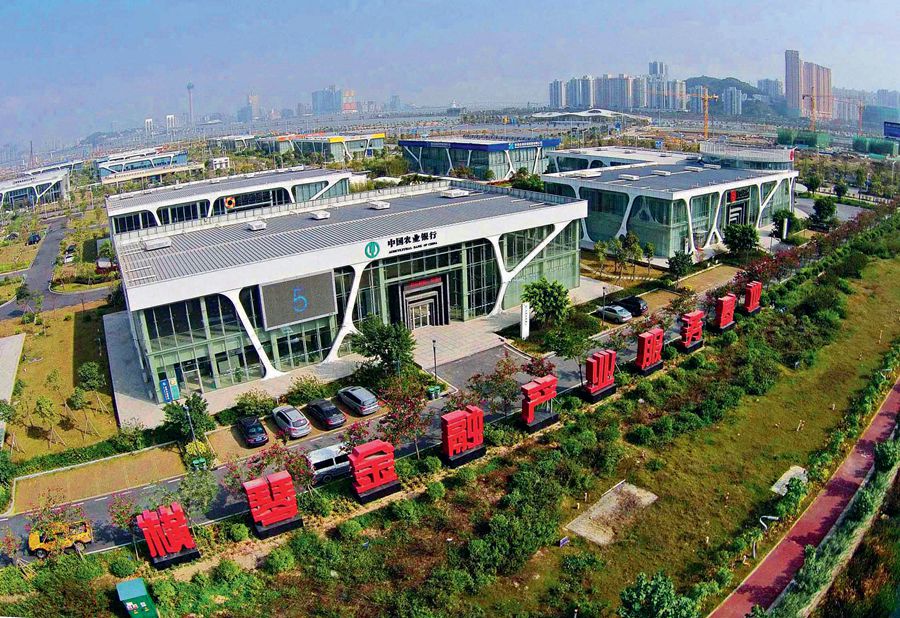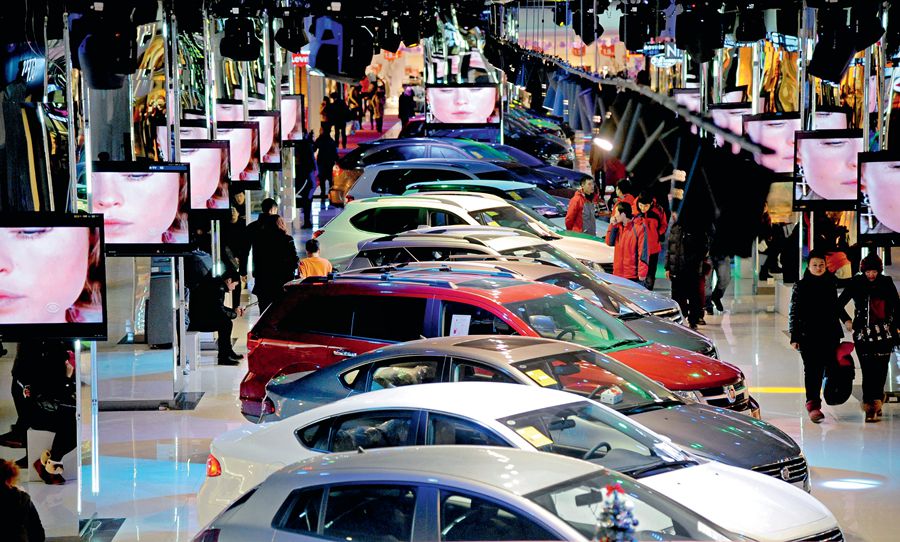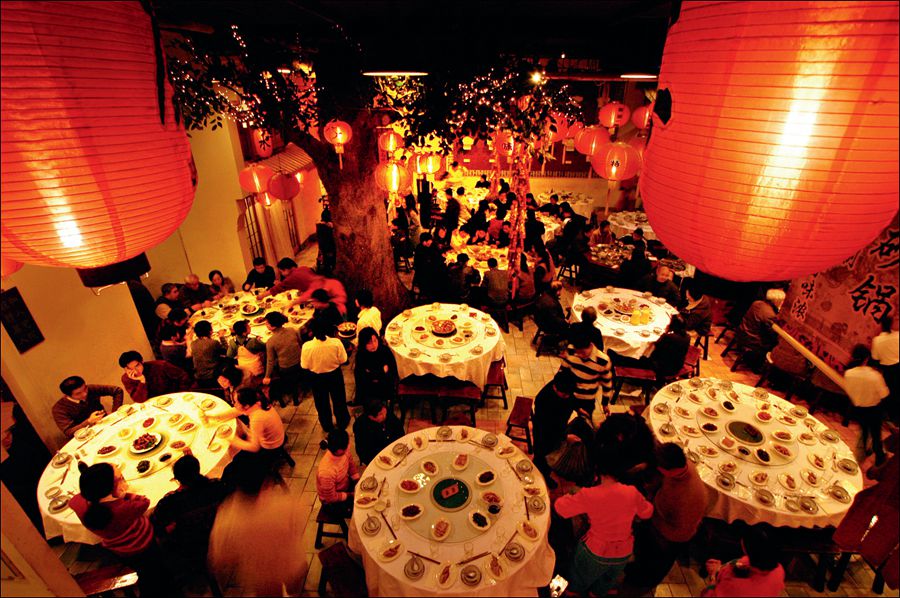CHINESE President Xi Jinping highlighted further reform and opening-up and high-quality development during a four-day inspection tour in South China’s Guangdong Province in October. He visited factories, a farming household, an urban residential community, and a university in the cities of Zhuhai, Qingyuan, Shenzhen, and Guangzhou.
In Shenzhen, Xi visited an exhibition on Guangdong’s development during the past 40 years since the reform and opening-up kicked off. Shenzhen was the first stop of Xi’s inspection tours after the 18th National Congress of the Communist Party of China. “I came here on these two occasions to tell the world that China’s reform and opening-up will not stop. China will create new miracles that impress the world,” he declared.

Aerial view of the Hengqin Free Trade Zone in Zhuhai, Guangdong Province, an inspecting tour stop by President Xi Jinping in October, 2018.
He reiterated that China will not close its door to the outside world, but will become more open during his tour to the Qianhai-Shekou area of Shenzhen in the China (Guangdong) Pilot Free Trade Zone.
Xi’s declarations made China’s future development course even clearer, and underscored its commitment to reform and opening-up. China has undergone many changes in terms of its composite strength and relations to the world in four decades. The changes confirm China’s determination to reform and open up, and bring the endeavor to a new historic starting point.
Common Prosperity
Forty years ago, the primary purpose of the decision of reform and opening-up was to shift the focus from class struggle to economic development. The most pressing issue for ordinary people was how to get rid of poverty and support themselves with adequate food and clothing. Poverty was ubiquitous at that time, and it was too tough a challenge to create wealth for all the people at once. Deng Xiaoping’s idea of allowing some to get rich first was in line with China’s conditions at that time.
Chinese diplomats’ experiences of the country’s backwardness were brought into sharp focus after their visits to other countries. Former Foreign Minister Li Zhaoxing recalled that many things like air-conditioners, taxis, paid parking lots, parking meters, drive-in cinemas, and animal shelters were all new to him in 1970 when he came to work in Chinese embassy in Kenya. It showed that the public facilities in Beijing were far poorer than those in Nairobi, capital of Kenya. The development gap was still distinct when he visited foreign countries at the inception of reform and opening-up. For example, China was still one of the 36 least developed countries in the world. The Chinese delegation was even envious of people’s life in former Yugoslavia when they visited the country. At that time, malls were called “baihuo stores,” which is literally translated into stores of hundreds of goods, as Chinese people regarded a store with over 100 goods as huge. Diplomats in the delegation joked that foreign malls should be dubbed “qianhuo stores,” which means stores with thousands of goods.

Consumerism is on the rise in Shenyang, Liao-ning Province.
Today, these stories are just jokes to many young people. In 40 years, China’s GDP mushroomed 33.5 fold, with an annual growth rate of 9.5 percent on average. GDP per capita, after adjusting for inflation, increased 22.8 fold with an annual real growth rate of 8.5 percent. People’s lives have totally changed with the economic miracle. The majority have bid farewell to lives of struggle and ushered in a modern life. In 1978, there were 770 million poor people in China, but the figure had decreased to 30.46 million by the end of last year.
Despite being few in number, the poor deserve to enjoy the benefits of reform and opening-up just like others. To this end, the CPC Central Committee placed poverty eradication on the top of its work agenda during its 19th National Congress, and pledged to raise all rural poor people out of poverty by 2020.
During his tour to Guangdong, Xi reiterated the commitment to poverty reduction, setting up a new benchmark to test the results of further reform and opening-up, which is whether common prosperity is achieved or not.
Taking Concrete Actions
Chinese liken reform to enlivening the country and opening-up to opening the door. The two reinforce and complete each other. In the past 40 years, China has been opening its door to the outside world to absorb everything that could boost its development, while it has been also invigorating the mechanisms to free and increase productivity.
There was a moment of historic significance among the series of moves to open the door 40 years ago. It happened on October 28, 1978 when Deng Xiaoping met with Konosuke Matsushita, founder of Panasonic Corporation, on his visit to Japan. Deng asked Matsushita to invest in China. Matsushita didn’t expect Deng would invite a capitalist enterprise to invest in a socialist China. On hearing Deng’s words, he was first surprised and then responded with resoluteness, “I will certainly go.” The partnership with Matsushita represents a common occurrence in the early days of opening-up, in which China brought in foreign capital, technologies, and management expertise.

Chinese families get together to enjoy a Chinese New Year’s Eve dinner at a restaurant on Hunan Road, Nanjing, in February 2006.
Forty years later Japanese Prime Minister Shinzo Abe paid a state visit to China on October 25-27, 2018. During his visit, the first forum on China-Japan third-party market cooperation was held in Beijing on October 26. A total of 52 cooperation agreements were signed, involving sectors of infrastructure, logistics, IT, finance, and energy.
It is a forum to carry out the initiative of third-party market cooperation proposed by China. As another innovation under the framework of the Belt and Road Initiative, third-party market cooperation aims to combine China’s production capability and the advanced technologies provided by developed economies with the development needs of developing countries for an optimized efficacy and win-win results.
Over the five years since its introduction, more than 100 countries and international organizations have set up partnerships with China to jointly implement the Belt and Road Initiative. In 2017, China’s direct non-financial investment in 59 countries along the Belt and Road totaled US $14.36 billion. By the end of 2017, Chinese businesses had built up 75 economic and trade cooperation zones in 24 countries along the Belt and Road, which had attracted 3,412 enterprises contributing total tax payments of US $2.21 billion to host countries and creating 209,000 local jobs.
Facts speak louder than words. Over the past decades China’s endeavor of opening up has evolved into a new pattern that is equally driven by going abroad and bringing in. While declaring its determination to further open up, China is reassuring the world with concrete actions. The first China International Import Expo, which opened in early November in Shanghai, is another major move signifying China’s steadfast support to free trade and economic globalization, and its proactive attitude towards further opening-up. As Xi said, “China’s door will never close, but only become more and more open.”
Overall Reform and Opening-up
The third plenary session of the 11th CPC Central Committee convened in December 1978 marked the beginning of reform and opening-up with guiding principles and concrete policies. Two other events in the same year are also important, although they are not as well-known as the third plenary session of the 11th CPC Central Committee.
The first is the release of an article in Guangming Daily on May 11, 1978. Titled “Practice is the Sole Criterion for Testing Truth,” the article triggered a nationwide debate on the criterion for truth, which further prepared Chinese people for the upcoming reform and opening-up. The second event happened in Xiaogang Village, East China’s Anhui Province. A total of 18 farmers signed a letter of commitment to introduce what later became known as the family land contract responsibility system in the same month when the third plenary session of the 11th CPC Central Committee was convened. It was a risky endeavor at a time when China had just ended the “cultural revolution (1996-1976).” But it was a forced choice farmers made after more than 60 fellow villagers had died of hunger. The authorities didn’t nip it in the bud, but allowed people to explore new practices autonomously. As a result, the household contract responsibility system was spread nationwide.
With rural areas adopting a more flexible production mode, factories in urban regions were exploring a new performance-based payment system. Reform and opening-up had been pushed forward step by step in this way. Also in 1978, some state-owned factories in Qingyuan, Guangdong Province ran into serious difficulties and were not able to pay their employees. Some suggested rewarding people who exceeded production targets to better motivate employees. Trials in four factories proved the practice to be a success. The Qingyuan experience was then spread to other places. On October 23 this year, President Xi once again visited Qingyuan and learned about local practices, like invigorating local industries with e-commerce for the efforts of poverty alleviation.
While marveling at the changes over the past 40 years, people noticed, on closer examination, that the reform and opening-up has developed into an overarching policy across the country instead of separate regional practices in its early years. From the initial reforms on agriculture, manufacturing, and the service sector to the current five-integrated plan of promoting coordinated economic, political, cultural, social, and ecological advancement, reform and opening-up is becoming all-encompassing in both coverage and depth.
President Xi called for pursuing reform in a more systematic, holistic, and coordinated way during his tour to Guangzhou in December 2012. Six years later, he once again stressed the requirement, specifying the direction for reform and opening-up in the new era.
An Endless Endeavor
Initially, China’s reform and opening-up was exploratory, with the adoption of a trial method. When carrying out the system of economic responsibility in the manufacturing sector in 1981, notions of “wading across the river by feeling the stones,” and “watching our steps to keep the two feet balanced, and restarting after making a misstep” were advocated. On discussing whether China should issue securities and stocks in 1992, Deng Xiaoping suggested a trial and error approach. “We allow people to reserve their judgments, but we must try these things out. If, after one or two years of experimentation, they prove feasible, we can expand them. Otherwise, we can put a stop to them and be done with it.”
As reform and opening-up went further, China’s economy grew larger, and situations at home and abroad become intertwined and more complicated. The cost of the trial and error method is much higher now than 40 years ago. Following cognitive rules, perceptual knowledge, and notions developed from trials are bound to be upgraded into a theoretical system.
During the recent tour to Guangdong, President Xi said, “We should fully appreciate that reform and opening-up under new circumstances is an up-to-date and systematic task that affects the whole landscape. We should push it forward at a higher starting point and level [and aim for] a higher target.” What he said points the direction of reform and opening-up from the perspective of methodology.
In general, China’s reform and opening-up will not stop, but will only be advanced in a holistic and more balanced manner. As Xi put it, reform and opening-up is an endless endeavor.
KOU LIYAN is an associate research fellow with China Center for Contemporary World Studies.


